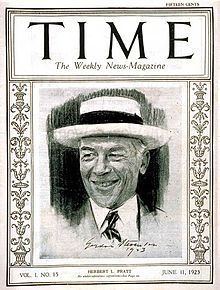Nationality American Role Businessman Siblings Frederic B. Pratt Name Herbert Pratt | Known for Head of Standard Oil Parents Charles Pratt Occupation Oil industrialist Died February 3, 1945 Nieces Mary Caroline Pratt | |
 | ||
Full Name Herbert Lee Pratt Born November 21, 1871 ( 1871-11-21 ) Brooklyn, New York Similar People Charles Pratt, John D Rockefeller, John D Rockefeller - Jr, Henry Huttleston Rogers, William Rockefeller | ||
Herbert Lee Pratt (November 21, 1871 – February 3, 1945) was an American businessman and a leading figure in the United States oil industry. In 1923, he became head of Standard Oil; his father Charles Pratt was a founder of Astral Oil Works, which later became part of Standard Oil. He lived and worked in New York City, as well as having a country estate, "The Braes" in Glen Cove, Long Island, and a hunting preserve and estate, "Good Hope Plantation" in Ridgeland, South Carolina. He was also an art collector and philanthropist.
Contents
Early life
Pratt was born in Brooklyn, New York in 1871, the fourth of six children of Mary Helen (née Richardson), his father's second wife, and Charles Pratt, the Standard Oil industrialist. His father's first wife, Lydia Richardson, had died young in 1861. He was brother to Frederic B. Pratt, George Dupont Pratt, Helen Pratt, John Teele Pratt and Harold I. Pratt. Their older half-siblings were Charles Millard Pratt and Lydia Richardson Pratt.
He took a degree of Bachelor of Arts at Amherst College in 1895.
Marriage and children
On April 28, 1897, Pratt married Florence Balsdon Gibb (daughter of John Gibb), and they had five children:
Career
Like his father, who was a pioneer in the independent oil industry and accepted a merger with Standard Oil, Pratt was a leading figure in the U.S. oil industry. He became head of Standard Oil Company of New York in 1923. This company eventually became Mobil.
Pratt was on the front cover of Time on June 11, 1923, when he replaced Henry Clay Folger as head of Standard Oil Company of New York. Pratt was also a director of Bankers Trust Company from 1917–38, and Asia Banking Corporation.
Death
His wife died in 1935. Pratt died in Manhattan, New York City on February 3, 1945, in his home at 834 Fifth Avenue, at the age of 73.
Residences and philanthropy
His country estate, "The Braes", in Glen Cove, Long Island, was built in 1912–14 and designed by James Brite in the neo-Jacobean style. It was the largest of the six Pratt family mansions at Glen Cove. It is now part of the Webb Institute.
In 1910, Pratt bought the 9,000-acre (36 km2) Good Hope plantation and hunting lodge in South Carolina (about five miles (8 km) from Ridgeland) from Harry B. Hollins, also of Long Island.
Pratt also spent summer months at his Japanese themed "camp," Pine Tree Point, on Upper St. Regis Lake, NY, which he purchased from Frederick William Vanderbilt in the early 1900s. He also spend some time at the Caughnawana Fishing and Hunting Club in Quebec, Canada.
In 1916, the 12-story 907 Fifth Avenue building, designed by J. E. R. Carpenter, was completed. It was the first building developed to replace one of the mansions previously fronting on Central Park. Pratt, then vice president of Standard Oil, rented the largest apartment, 25 rooms and eight baths, occupying the entire top floor, at an annual rent of $30,000.
Pratt soon outgrew this residence and moved to the central of three beaux-arts mansions at 84th and Fifth Avenue. He sold the building in 1936 to the Marymount School who combined the building with its neighbors but preserved all the exteriors and much of the interiors.
Pratt was an art collector, particularly of portraits and miniatures. When Rotherwas Court, Herefordshire, England, was dismantled and auctioned in 1913, Pratt purchased the dining room for his neo-Jacobean mansion "The Braes," then under construction as a country estate in Glen Cove. His bequest to Amherst College included the Rotherwas Room and more than 80 American portraits and miniatures, as well as an extensive collection of decorative arts. The Rotherwas Room was incorporated into the Mead Art Museum, when it was built at Amherst College in 1949.
The Webb Institute of Naval Architecture acquired "The Braes" in 1945 for use as its campus. After renovation, it held its first classes there in 1947. Additions have included a library, model facility and other features.
